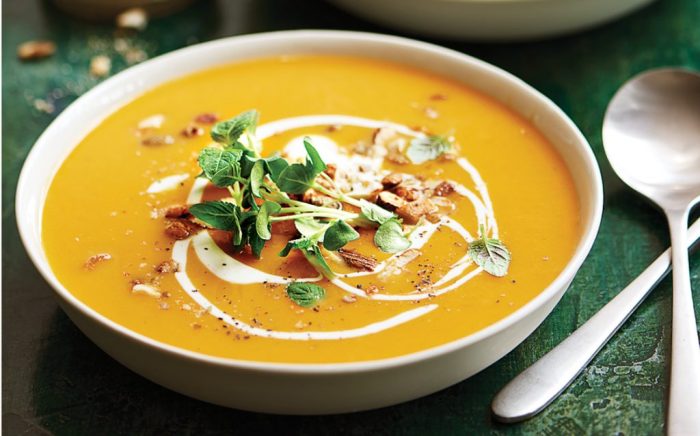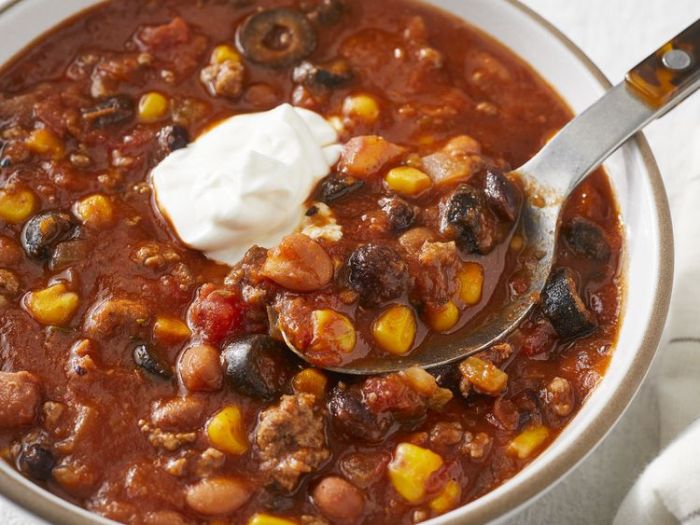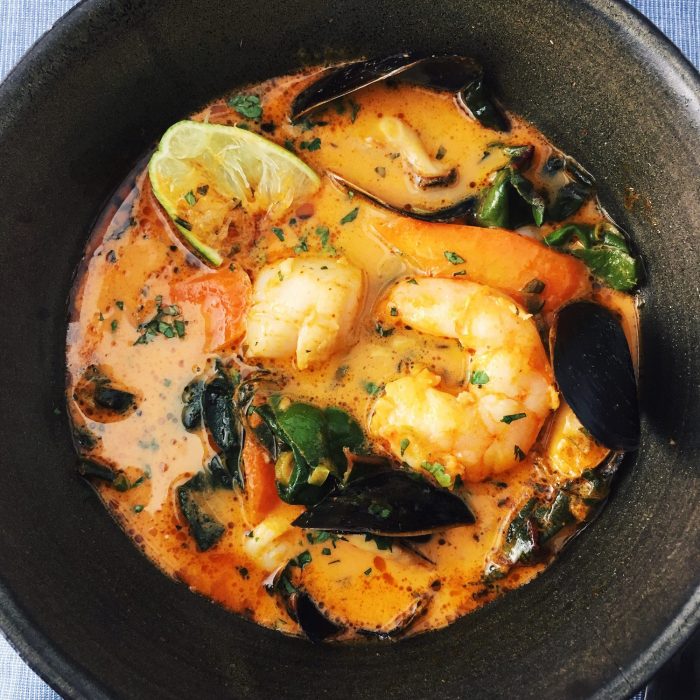Creamy Pumpkin Soup Variations
Recipe pumpkin soup cream – This section explores three distinct pumpkin soup recipes, each showcasing a different level of creaminess: low, medium, and high. We’ll delve into the ingredient specifics, step-by-step instructions, and a comparative analysis to highlight the impact of cream type and quantity on the final product.
Pumpkin Soup Creaminess Levels

Source: healthyfood.com
The creaminess of pumpkin soup is significantly influenced by the type and amount of cream used, as well as the cooking method. Here, we present three variations, ranging from subtly creamy to luxuriously rich.
- Low-Cream Pumpkin Soup: This version prioritizes the natural sweetness of the pumpkin and utilizes a minimal amount of cream for a lighter, healthier option. Ingredients include roasted pumpkin puree, vegetable broth, onions, garlic, ginger, cinnamon, and a touch of half-and-half. The cooking process involves sautéing aromatics, simmering the pumpkin puree in broth, and blending until smooth. A final stir of half-and-half adds a subtle creaminess without overwhelming the pumpkin flavor.
- Medium-Cream Pumpkin Soup: This recipe balances the pumpkin’s flavor with a moderate amount of cream for a satisfyingly creamy texture. Ingredients include roasted pumpkin puree, vegetable broth, onions, garlic, nutmeg, and half-and-half. The method involves similar sautéing and simmering steps, but the addition of half-and-half is increased to achieve a creamier consistency. A touch of heavy cream can be added for extra richness.
- High-Cream Pumpkin Soup: This recipe indulges in a rich and luxurious creaminess, perfect for a special occasion. Ingredients include roasted pumpkin puree, vegetable broth, onions, garlic, cinnamon, and a generous amount of heavy cream or coconut cream. The cooking process is similar, but the substantial addition of heavy cream (or coconut cream for a vegan option) creates a velvety smooth and intensely creamy texture.
Recipe Comparison Table
The following table summarizes the key differences between the three pumpkin soup recipes.
| Recipe | Cream Type & Amount | Texture | Flavor Profile |
|---|---|---|---|
| Low-Cream | Small amount of half-and-half | Smooth, light | Pumpkin-forward, subtly creamy |
| Medium-Cream | Moderate amount of half-and-half, optional touch of heavy cream | Smooth, creamy | Balanced pumpkin and cream flavors |
| High-Cream | Generous amount of heavy cream or coconut cream | Velvety smooth, rich | Intensely creamy, pumpkin flavor present but less prominent |
Impact of Cream Type
The choice of cream significantly impacts the soup’s taste and consistency. Heavy cream provides a rich, decadent texture and a slightly buttery flavor. Coconut cream offers a unique, slightly sweet and tropical twist, making it a popular choice for vegan versions. Half-and-half provides a milder creaminess, allowing the pumpkin flavor to shine through.
Ingredient Sourcing and Preparation
Selecting the right pumpkin and properly preparing the ingredients are crucial for achieving a delicious and creamy soup. This section details the best pumpkin varieties, roasting techniques, and preparation methods for other key ingredients.
Pumpkin Selection and Roasting

Source: tasteofhome.com
For the creamiest soup, choose pumpkins known for their sweetness and dense flesh, such as Sugar Pie pumpkins or Kabocha squash. Their high sugar content contributes to a richer, more flavorful soup.
- Preheat oven to 400°F (200°C).
- Cut the pumpkin in half, remove seeds and stringy bits.
- Place cut-side down on a baking sheet.
- Roast for 45-60 minutes, or until tender.
- Scoop out the flesh and puree.
Preparing Other Ingredients
Proper preparation of onions, garlic, and spices enhances the soup’s overall flavor complexity. Sautéing onions and garlic until softened brings out their sweetness and depth. Toasting spices like cinnamon and nutmeg before adding them to the soup intensifies their aromatic qualities.
Cooking Methods and Techniques: Recipe Pumpkin Soup Cream
This section compares different cooking methods for pumpkin soup, focusing on achieving a perfectly smooth and velvety texture. We’ll also provide tips to prevent the soup from becoming too watery or thick.
Cooking Method Comparison
Pumpkin soup can be prepared using various methods, each with its advantages and disadvantages.
- Stovetop: Offers precise control over the cooking process and allows for easy adjustments to consistency. It’s a quick and efficient method.
- Slow Cooker: Ideal for hands-off cooking. The low and slow cooking method gently extracts flavors and results in a tender pumpkin puree. However, it may require longer cooking time.
- Instant Pot: Provides a fast and convenient way to cook pumpkin soup. The pressure cooking method tenderizes the pumpkin quickly. However, it can be less forgiving if not monitored carefully.
Blending and Straining Techniques
For a perfectly smooth and velvety texture, blend the soup thoroughly using an immersion blender or a regular blender. For an exceptionally smooth consistency, strain the soup through a fine-mesh sieve to remove any fibers.
Tips for Consistency
To avoid a watery soup, ensure the pumpkin is properly roasted and not overcooked. To prevent a thick soup, adjust the amount of broth accordingly. A cornstarch slurry can be used to thicken the soup if needed.
Flavor Profiles and Enhancements
This section explores unique flavor combinations and the impact of spices and aromatics on the overall taste of pumpkin soup.
Unique Flavor Combinations
The basic pumpkin soup recipe can be easily customized with various flavor additions.
- Curry Pumpkin Soup: Adds a warm, savory spice profile.
- Maple Pumpkin Soup: Introduces a touch of sweetness and maple’s distinct flavor.
- Chipotle Pumpkin Soup: Provides a smoky, slightly spicy kick.
- Ginger Pumpkin Soup: Offers a vibrant, warming spice note.
- Sage Pumpkin Soup: Adds an earthy, herbaceous aroma.
Impact of Spices
Spices such as cinnamon, nutmeg, and ginger contribute warmth and complexity to the soup. Cinnamon offers a sweet, warm spice note, nutmeg adds a subtle earthiness, and ginger provides a zesty, pungent flavor.
Creamy pumpkin soup is a delightful autumnal dish, offering a comforting warmth. For a savory contrast, consider a completely different flavor profile, like the umami punch of recipe for Lipton onion soup burgers , which offers a bold, savory alternative. Returning to the pumpkin soup, remember to adjust the seasoning to your preference for the perfect balance of sweet and savory notes.
Role of Aromatics
Aromatics like onions, garlic, and shallots build depth and complexity. They provide a savory base that complements the sweetness of the pumpkin.
Serving Suggestions and Garnishes
This section provides suggestions for serving pumpkin soup and enhancing its visual appeal with various garnishes.
Garnish Options
| Garnish | Description | Flavor Enhancement | Visual Appeal |
|---|---|---|---|
| Toasted Pepitas | Roasted pumpkin seeds | Adds nutty crunch and subtle sweetness | Adds textural contrast and color |
| Crème Fraîche | Thick cultured cream | Adds richness and tanginess | Creates a creamy swirl and adds visual interest |
| Crispy Sage | Deep-fried sage leaves | Adds savory herbaceous flavor | Adds pops of green color and texture |
| Croutons | Small pieces of toasted bread | Adds crunch and savory flavor | Adds textural contrast and visual interest |
Serving Ideas, Recipe pumpkin soup cream
Pumpkin soup can be served as a starter, main course, or side dish. It pairs well with grilled cheese sandwiches, crusty bread, or a simple salad.
Visual Presentation
The visual presentation of pumpkin soup significantly impacts the dining experience. This section describes the ideal characteristics and how presentation elements enhance the overall appeal.
Ideal Appearance
A perfectly made cream of pumpkin soup should have a vibrant, deep orange color, a smooth and velvety texture, and a creamy consistency. The color may vary slightly depending on the pumpkin variety and cooking method.
Visual Aspects
The color of the soup can range from a pale orange to a deep, rich orange depending on the pumpkin variety and cooking method. A smooth, velvety texture indicates proper blending and straining. The bowl type and garnish placement contribute to the overall visual appeal. A rustic bowl enhances a homely feel, while a sleek bowl presents a more sophisticated look.
Presentation Impact
Careful attention to presentation enhances the overall dining experience. A beautifully presented bowl of soup invites the diner to savor both the taste and the visual appeal. The garnish placement should be considered to add both visual and textural interest.
Expert Answers
Can I make this soup ahead of time?
Yes, pumpkin soup can be made a day or two in advance. Store it in an airtight container in the refrigerator and reheat gently before serving.
What if my soup is too thick?
Add a little broth or water, a tablespoon at a time, until you reach your desired consistency.
What if my soup is too thin?
Simmer the soup uncovered for a few minutes to reduce the liquid. Alternatively, you can thicken it with a cornstarch slurry (1 tablespoon cornstarch mixed with 2 tablespoons cold water).
What are some vegetarian/vegan cream alternatives?
Coconut cream, cashew cream, or full-fat coconut milk are excellent vegan alternatives. For vegetarian options, consider using half-and-half or a plant-based cream alternative.


